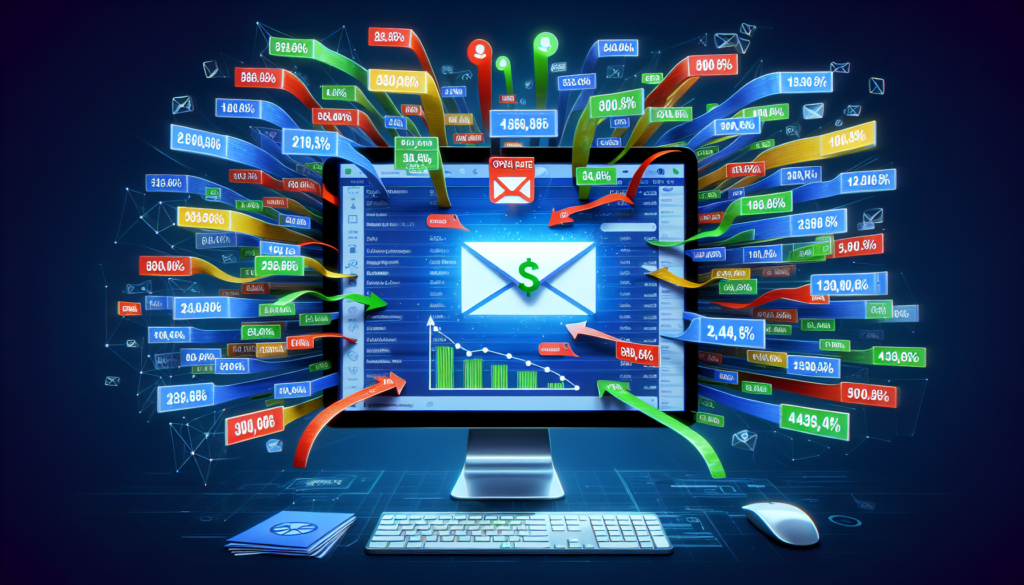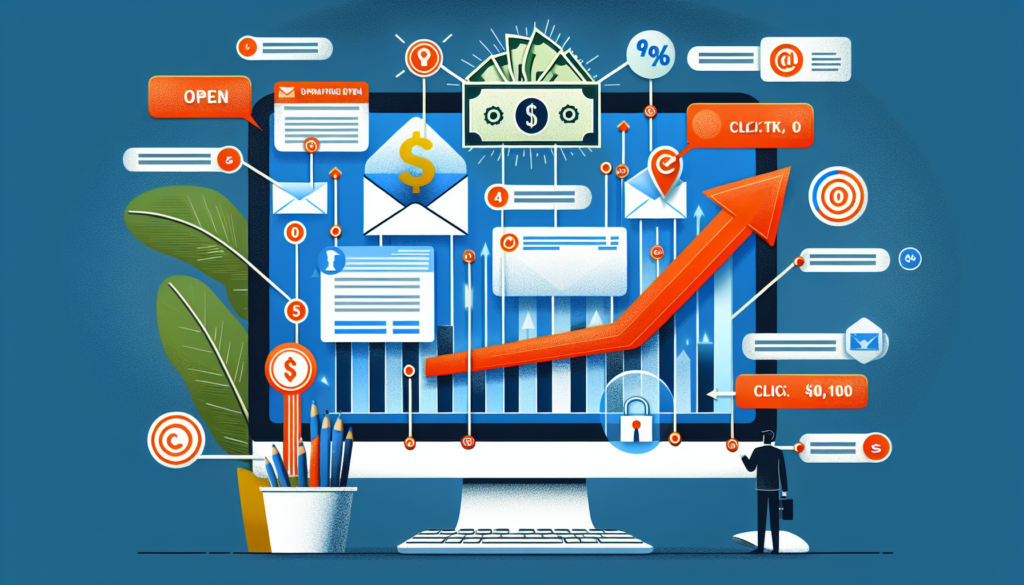Imagine being able to send a single email to thousands of potential customers with the potential of earning a significant return on your investment. Sounds too good to be true, right? Well, email marketing has proven to be an incredibly effective tool for businesses of all sizes. But what are the key factors that can affect the average return on email marketing? In this article, we will explore some of the most important elements that can make or break your email marketing campaign success. So get ready to learn the secrets to achieving a high return on your email marketing efforts and unlocking the true potential of this powerful marketing tool. The average return on email marketing can vary greatly depending on several key factors. In order to maximize your email marketing ROI, it is important to consider these factors and make strategic decisions based on them. In this article, we will explore the various elements that can influence the average return on email marketing and provide insights into how to optimize each aspect.

1. Target Audience
1.1 Specific Demographics
Understanding your target audience is crucial for effective email marketing. By identifying the specific demographics of your audience, such as age, gender, location, and interests, you can tailor your email content to resonate with them. This personalized approach increases the chances of engagement and conversion.
1.2 Email List Quality
The quality of your email list plays a significant role in determining the success of your email marketing campaigns. A high-quality email list consists of engaged and interested subscribers who are more likely to respond positively to your emails. Minimize the number of fake or inactive email addresses, as they can negatively impact your deliverability and engagement rates.
1.3 Relevance of Content
Relevance is key when it comes to email marketing. Ensuring that the content of your emails aligns with the interests and needs of your subscribers is crucial for driving engagement and conversions. By delivering valuable and timely content, you can enhance the overall user experience and increase the likelihood of achieving a higher return on investment (ROI).
2. Email List Size
2.1 Growth Strategies
Growing your email list is essential for expanding your reach and increasing the potential return on email marketing. Implementing effective growth strategies, such as offering incentives, creating compelling lead magnets, and utilizing social media, can help attract new subscribers. Consistently focusing on list growth will provide you with a larger and more engaged audience to target.
2.2 List Cleanliness
Maintaining a clean email list is vital for maximizing the deliverability and engagement rates of your email campaigns. Regularly cleaning your list by removing inactive subscribers, addressing bounces, and eliminating spam traps will improve the overall quality of your list. A clean list ensures that your emails reach real and interested recipients, increasing the chance of generating a positive ROI.
2.3 List Segmentation
Segmenting your email list allows you to create targeted and personalized campaigns based on specific criteria. By dividing your list into different segments, such as demographics, purchase history, or engagement, you can send more relevant content to each subgroup. This level of personalization enhances the user experience and increases the likelihood of conversions.
3. Email Deliverability
3.1 Sender Reputation
Maintaining a positive sender reputation is crucial for email deliverability. ISPs and email filters consider the sender’s reputation when deciding whether to deliver an email to the recipient’s inbox or spam folder. By adhering to best practices, such as sending emails only to engaged subscribers, avoiding spam complaints, and regularly monitoring your deliverability metrics, you can maintain a good sender reputation.
3.2 Email Authentication
Implementing email authentication protocols, such as SPF (Sender Policy Framework) and DKIM (DomainKeys Identified Mail), enhances the credibility of your emails. These protocols verify that your emails are genuine and not forged or spoofed. Proper email authentication increases the chances of your emails reaching the recipient’s inbox, improving deliverability and ultimately impacting the average return on email marketing.
3.3 Spam Filter Avoidance
Avoiding spam filters is crucial for successful email marketing. To ensure that your emails bypass spam filters, avoid using trigger words and phrases commonly associated with spam, personalize your emails, and consistently monitor your spam complaint rates. Creating high-quality, relevant content is also important in avoiding being flagged as spam.
4. Email Design and Content
4.1 Clear Call-to-Action
An effective email design includes a clear and compelling call-to-action (CTA) that prompts the recipient to take the desired action. Whether it’s making a purchase, signing up for a webinar, or downloading a resource, the CTA should be visually appealing and prominently displayed. A well-designed and strategically placed CTA increases the likelihood of conversion and positively impacts the return on email marketing.
4.2 Mobile Optimization
With the increasing use of smartphones, ensuring that your emails are mobile-optimized is crucial. Responsive email design ensures that your emails adapt to different screen sizes and devices, providing a seamless user experience. By optimizing your emails for mobile, you can reach a larger audience and improve engagement rates, thereby increasing the potential return on investment.
4.3 Personalization
Personalized emails resonate more with recipients and are more likely to drive engagement. Use personalized data, such as the recipient’s name, location, or past purchase history, to tailor your email content. This level of personalization creates a sense of relevance and connection, attracting the recipient’s attention and increasing the chances of achieving a higher return on email marketing.
4.4 Visual Appeal
Visual appeal plays a significant role in capturing the recipient’s attention and increasing email engagement. Use visually appealing graphics, images, and videos to make your emails visually enticing. However, ensure that the visuals complement your content and do not overshadow the message. A visually appealing email design is more likely to evoke positive responses and drive conversions.

5. Subject Lines
5.1 Clarity and Relevance
Crafting clear and relevant subject lines is essential for improving email open rates. The subject line should provide a glimpse into the content of the email while piquing the recipient’s curiosity. Avoid misleading or clickbait subject lines, as they can negatively impact your sender reputation and decrease engagement rates. A clear and relevant subject line increases the chances of your email being opened and positively impacts the average return on email marketing.
5.2 Personalization
Personalizing subject lines by including the recipient’s name or other relevant data adds a personal touch to your emails. This level of personalization increases open rates and engagement as it creates a sense of relevance and connection. Utilize personalization tokens and segmentation to tailor subject lines to each specific audience segment.
5.3 A/B Testing
A/B testing subject lines allows you to understand what resonates best with your audience. Test different subject lines to determine which ones drive higher open rates and engagement. By continuously optimizing your subject lines through A/B testing, you can refine your email marketing strategy and improve the average return on email marketing.
6. Email Frequency
6.1 Overwhelming Subscribers
Avoid overwhelming your subscribers with excessive email frequency. Bombarding them with emails can lead to email fatigue and potential unsubscribes. Strike a balance by spacing out your emails and considering the preferences and engagement levels of your subscribers. Monitoring engagement metrics and adjusting your email frequency accordingly can help maintain a healthy subscriber base and improve the average return on email marketing.
6.2 Non-existent Communication
On the other end of the spectrum, non-existent communication can also hinder the average return on email marketing. Consistency is crucial in building customer relationships and nurturing leads. Ensure you regularly communicate with your subscribers by sending relevant and valuable content. By maintaining consistent communication, you can keep your brand top of mind and increase engagement rates.
6.3 Finding the Right Balance
Finding the right balance in email frequency is key. Tailor your email schedule to your specific audience, taking into consideration their preferences and engagement patterns. Analyze engagement metrics to determine optimal frequency intervals. Opting for a frequency that maximizes engagement without overwhelming subscribers is vital for achieving a higher average return on email marketing.

7. Automation and Segmentation
7.1 Targeted Campaigns
Utilizing automation and segmentation allows you to send targeted campaigns to specific segments of your email list. By automating email workflows based on customer behavior or specific triggers, you can deliver personalized content at the right time. Targeted campaigns improve engagement rates and conversion rates, positively impacting the average return on email marketing.
7.2 Customer Behavior Tracking
Tracking customer behavior through data collection and analysis provides valuable insights into your subscribers’ preferences and interests. Utilize this data to segment your email list and develop targeted campaigns. By understanding your subscribers’ behavior, you can send relevant content that aligns with their needs, increasing the chances of conversion and overall ROI.
7.3 Dynamic Content
Dynamic content allows you to personalize email campaigns further by displaying content based on specific criteria. By utilizing dynamic content, such as personalized recommendations or location-specific offers, you can deliver a highly personalized experience to your subscribers. This level of customization enhances engagement and promotes higher returns on email marketing efforts.
8. Email Timing
8.1 Day of the Week
Determining the optimal day of the week to send your emails can significantly impact the open and engagement rates. Analyze your subscriber’s behavior to identify patterns and preferences. Consider factors such as industry norms, target audience characteristics, and the purpose of your email when determining the best day to send your emails.
8.2 Time of Day
Timing is crucial when it comes to email marketing. Analyze engagement metrics to determine the best time of day to send your emails. Consider factors such as the recipients’ time zones, their workplace habits, and the specific content of the email. Sending emails at the right time increases the chances of your emails being seen and acted upon, positively impacting the average return on email marketing.
8.3 Time Zone Considerations
If your target audience spans multiple time zones, consider segmenting your email list based on time zones. By delivering content at appropriate local times, you can maximize engagement and ensure that your emails are not overlooked due to time differences. Taking time zone considerations into account demonstrates a dedication to providing a personalized experience, ultimately influencing the average return on email marketing.

10. Brand Reputation and Trust
10.1 Consistency and Quality
Consistency in your email marketing efforts helps build trust and establish a solid brand reputation. Ensure that your emails reflect your brand’s values and tone consistently. Deliver high-quality and valuable content consistently to maintain a positive perception and foster trust with your subscribers. By consistently delivering high-value emails, you can improve the average return on email marketing.
10.2 Privacy and Security
Privacy and security are paramount in email marketing. Clearly communicate your data protection practices and ensure that subscribers’ personal information is safeguarded. Implement robust security measures to protect against data breaches or unauthorized access. Building trust through a strong focus on privacy and security increases subscriber confidence and boosts engagement rates.
10.3 Subscriber Engagement
Engaging with your subscribers is essential for maintaining a healthy relationship and improving the average return on email marketing. Encourage interaction and feedback by including social share buttons, response options, and surveys in your emails. Actively addressing responses and feedback demonstrates that you value your subscribers’ opinions and fosters a sense of community. Strong subscriber engagement leads to increased loyalty and improved ROI.
In conclusion, achieving a higher average return on email marketing requires a comprehensive understanding of the various factors that influence success. From targeting the right audience and maintaining a high-quality email list to optimizing email design, subject lines, and frequency, each element plays a crucial role in achieving optimal results. By implementing these strategies and continually analyzing and refining your approach, you can maximize the effectiveness of your email marketing campaigns and achieve a higher average return on email marketing.










